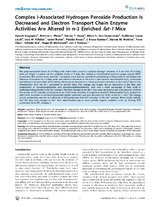Mostrar el registro sencillo del ítem
Complex I-Associated Hydrogen Peroxide Production Is Decreased and Electron Transport Chain Enzyme Activities Are Altered in n-3 Enriched fat-1 Mice
| dc.contributor.author | Hagopian, Kevork | |
| dc.contributor.author | Weber, Kristina L. | |
| dc.contributor.author | Hwee, Darren T. | |
| dc.contributor.author | Van Eenennaam, Alison L. | |
| dc.contributor.author | López-Lluch, Guillermo | |
| dc.contributor.author | Villalba, José Manuel | |
| dc.contributor.author | Burón, Isabel | |
| dc.contributor.author | Navas Lloret, Plácido | |
| dc.contributor.author | German, Bruce | |
| dc.contributor.author | Watkins, Steven | |
| dc.contributor.author | Chen, Yana | |
| dc.contributor.author | Wei, Alfreda | |
| dc.contributor.author | McDonald, Roger B. | |
| dc.contributor.author | Ramsey, Jon J. | |
| dc.date.accessioned | 2013-12-23T09:28:35Z | |
| dc.date.available | 2013-12-23T09:28:35Z | |
| dc.date.issued | 2010 | |
| dc.identifier.uri | http://hdl.handle.net/10396/11516 | |
| dc.description.abstract | The polyunsaturated nature of n-3 fatty acids makes them prone to oxidative damage. However, it is not clear if n-3 fatty acids are simply a passive site for oxidative attack or if they also modulate mitochondrial reactive oxygen species (ROS) production. The present study used fat-1 transgenic mice, that are capable of synthesizing n-3 fatty acids, to investigate the influence of increases in n-3 fatty acids and resultant decreases in the n-6:n-3 ratio on liver mitochondrial H2O2 production and electron transport chain (ETC) activity. There was an increase in n-3 fatty acids and a decrease in the n-6:n-3 ratio in liver mitochondria from the fat-1 compared to control mice. This change was largely due to alterations in the fatty acid composition of phosphatidylcholine and phosphatidylethanolamine, with only a small percentage of fatty acids in cardiolipin being altered in the fat-1 animals. The lipid changes in the fat-1 mice were associated with a decrease (p,0.05) in the activity of ETC complex I and increases (p,0.05) in the activities of complexes III and IV. Mitochondrial H2O2 production with either succinate or succinate/glutamate/malate substrates was also decreased (p,0.05) in the fat-1 mice. This change in H2O2 production was due to a decrease in ROS production from ETC complex I in the fat-1 animals. These results indicate that the fatty acid changes in fat-1 liver mitochondria may at least partially oppose oxidative stress by limiting ROS production from ETC complex I. | es_ES |
| dc.format.mimetype | application/pdf | es_ES |
| dc.language.iso | eng | es_ES |
| dc.publisher | Public Libray of Science (PLOS) | es_ES |
| dc.rights | https://creativecommons.org/licenses/by-nc-nd/4.0/ | es_ES |
| dc.source | PLoS ONE 5 (9) (2010) | es_ES |
| dc.subject | n-3 fatty acids | es_ES |
| dc.subject | oxidative damage | es_ES |
| dc.title | Complex I-Associated Hydrogen Peroxide Production Is Decreased and Electron Transport Chain Enzyme Activities Are Altered in n-3 Enriched fat-1 Mice | es_ES |
| dc.type | info:eu-repo/semantics/article | es_ES |
| dc.rights.accessRights | info:eu-repo/semantics/openAccess | es_ES |

